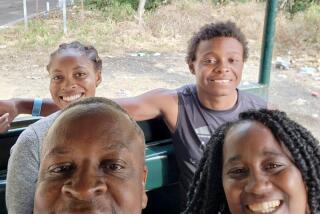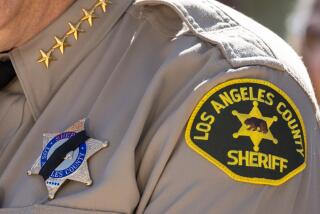Amid police shootings, Albuquerque residents grow fearful
ALBUQUERQUE — When Wynema and Michael Gonzagowski moved to town about two years ago, family and friends warned them about what they described as the heavy-handed tactics and aggressive attitude of Albuquerque police.
At first the couple brushed off the warnings, saying things couldn’t be as bad as what they had experienced in Los Angeles in the LAPD’s Rampart Division, which became infamous for corruption in its anti-gang unit in the 1990s.
But the Gonzagowskis, like others here, began to grow suspicious of their Police Department.
They noticed police regularly stopping and questioning young men and homeless people in their low-income neighborhood.
The Gonzagowskis became upset, they said, when they saw a video that surfaced in March, showing the fatal police shooting of James “Abba” Boyd, a homeless and mentally ill man who was illegally camping in the Sandia Mountains.
But when they saw officers gun down their neighbor Alfred Lionel Redwine on March 25, the Gonzagowskis said, they lost faith in the police.
“I’ve never been scared of cops, but out here, the cops terrify me,” said Michael Gonzagowski, 39.
He’s not alone.
A rash of officer-involved shootings has unleashed anger, resentment and self-examination as residents, City Hall and the police question whether Albuquerque needs to overhaul the department and train officers better, particularly in how to react to people with mental illness.
Providing better training and mental health services, many here acknowledge, is all the more difficult because New Mexico is a poor state with underfunded behavioral health programs.
Tension between police and parts of the community has been building for years.
“They treat you like you’re out looking to cause trouble every time they talk to you,” Michael Gonzagowski said. For him, the Redwine shooting was the last straw.
In a news conference, Albuquerque Police Chief Gorden Eden Jr. said Redwine was armed and fired a gun before officers shot him during a standoff at a public housing complex.
But Wynema Gonzagowski, a 53-year-old film technician who said she witnessed the entire incident, said she didn’t see a gun on Redwine and that he had his arms down, with his palms out, when officers shot him.
“They didn’t warn him, they didn’t tell him to freeze and get on the ground or to put his hand behind his head. They just opened fire,” she said.
Since 2010, Albuquerque police have shot 37 people, 23 of them fatally. The shootings have prompted the U.S. Justice Department to open an investigation into police conduct.
For many in this city of 550,000 people, a turning point came with the video of the March 16 shooting. Before he was shot, Boyd had been acting erratically. The video touched off mass protests — including a violent confrontation between police and protesters March 30. Boyd’s killing prompted another federal investigation.
Mayor Richard J. Berry called Boyd’s death a “game changer” and urged the Justice Department to expedite its investigation. He also introduced a raft of proposed “sweeping changes” to be implemented by Eden, who has been police chief for about a month.
The list includes crisis intervention training for all field service bureau officers. As of now, about a quarter of them receive such training.
Berry said the reforms would include a more rigorous evaluation system for officers, along with comprehensive background checks and evaluations for those hired from other departments.
Critics say a hiring surge around 2005 led the police to bring in officers who weren’t well-vetted.
Berry noted that after a spate of officer-involved shootings in 2009, Albuquerque began several reforms — including lapel cameras, which captured Boyd’s shooting.
“I know we can do things better,” Berry said. “I want to do things better.”
But the mayor says he doesn’t want the changes to be construed as an indictment of the Police Department. In an interview, he said Boyd’s killing — although tragic — didn’t reflect the performance of the police as a whole.
Eden agreed. “My goal is to make major reforms to the department. ... The better we get, the better we build confidence,” he said.
The relationship between Albuquerque police and residents — especially the homeless and the poor— has been strained for decades, said David Correia, an assistant professor at the University of New Mexico.
Albuquerque has gone through several waves of proposed reforms that followed reports or audits of the police, said Correia, who has studied police violence for 15 years.
Each time the same reforms are recommended: new leadership, better training, improved pay, more qualified officers.
But the reforms, Correia said, “don’t get into the more troubling issue: The culture of violence and the heavy militarized approach” of the police.
New Mexico’s fragile and woefully underfunded mental health system compounds the problem, said Patsy Romero, president of the state chapter of the National Alliance for Mental Illness.
About 75% of those shot by Albuquerque police had some sort of mental illness, she said. Boyd was one of them.
New Mexico has the highest rate of suicide in the nation, Romero said. It also ranks near the bottom for per capita funding for mental health services.
“We’ve got some very serious problems in New Mexico with regards to mental health treatment, and it’s going to take all the community to come together to figure how we’re going to fix it or more lives are going to be lost,” she said. “I’m not talking about just death, but whenever someone cannot be treated in a community level and ends up in a hospital or jail or shot. Those are the losses we’re talking about it.”
Berry is calling for a state law that would empower a judge to order a mentally ill person to take medication or seek treatment if he posed a danger to himself or others.
But Democratic state Sen. Jerry Ortiz y Pino, who represents portions of Albuquerque, said such a law would make matters worse and flood local jails. Anyone who couldn’t get the mental health services they needed would end up violating the judge’s orders.
“I think that unless we had a terrific network of resources out there for the mentally ill, we can’t do that,” he said. “We need to build up our service network first.”
In an attempt to address the concerns and fears raised by Boyd’s death, Berry and Eden have proposed spending $1 million on police training, especially in dealing with people with mental illness.
But Wynema Gonzagowski, who has had trouble sleeping after the Redwine shooting, is skeptical.
“The civil unrest is getting worse and worse,” she said. “It’s wrong. That badge is supposed to protect us, not kill us.”
More to Read
Start your day right
Sign up for Essential California for news, features and recommendations from the L.A. Times and beyond in your inbox six days a week.
You may occasionally receive promotional content from the Los Angeles Times.







